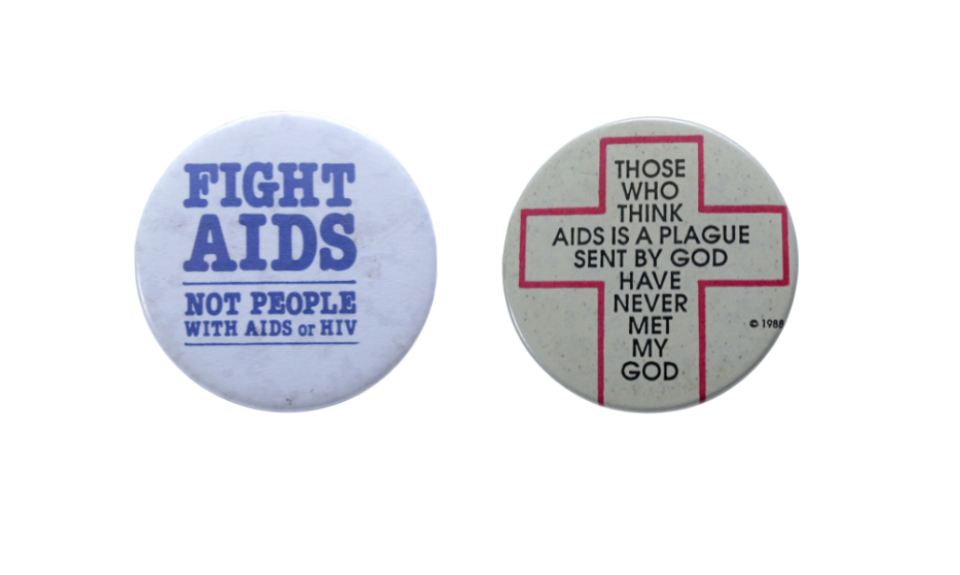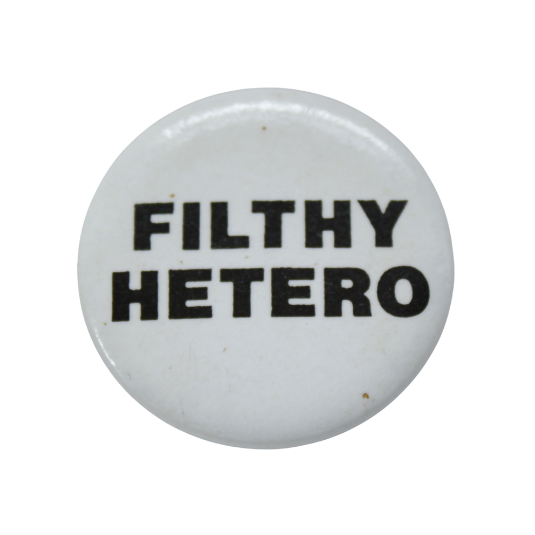For Manchester Pride we take a deep dive with PHM Collections Assistant Morgan Beale into the museum’s recently digitised LGBTQIA+ badge collection. Morgan explores the history of the symbols and slogans, some of which are subtle and others proudly visible.
There are over 300 LGBTQIA+ (Lesbian, Gay, Bisexual, Trans, Queer, Intersex, Asexual +) badges among thousands of badges in the collection at People’s History Museum.
We use ‘LGBTQIA+’ as a label as sometimes we can’t be sure how a person or group would identify, so this is an inclusive way to cover all marginalised sexualities and gender identities. The words people use to describe themselves are constantly evolving; slurs can be reclaimed, while some terms naturally fall out of use. As a museum, we aim to keep up with how communities self-describe, so ‘LGBTQIA+’ will likely change again in the future.
There is plenty of overlap between the LGBTQIA+ movement and other campaigns in all areas of our collection. A badge may be tagged ‘LGBTQIA+’ for an obvious reason – those from Pride protests, LGBTQIA+ charities and campaigns, or with related symbols and slogans. Others are categorised as LGBTQIA+ for their connection to a specific person. For example, almost half of the collection was donated by Ernest Hole, the co-founder of Gay’s The Word, the oldest LGBT bookshop in the UK. While most of his badges are from LGBTQIA+ organisations, some are instead from the peace and anti-racist movements.
His bulk donation also included numerous 1st birthday badges – an accident or an LGBTQIA+ in-joke? It’s hard to tell! Sometimes we’re not sure of the significance of particular slogans or designs, especially as marginalised stories have historically been under-researched. If you have any insight we haven’t spotted while searching the collection online or visiting the museum, please let us know!

Since the growth of the LGBTQIA+ rights movement in the 1960s, a number of symbols and phrases have become synonymous with the community. The now-ubiquitous rainbow was first designed by Gilbert Baker in 1978, but others have fallen out of use somewhat.
Repeatedly featured in the collection is the lambda, for example. The Greek letter was first chosen by designer Tom Doerr as the logo of the Gay Activists Alliance in New York in 1970. Four years later, it was adopted as a symbol for the movement at the International Gay Rights Congress in Edinburgh. Other common symbols relate to specific moments or organisations, such as the spiderweb. Sometimes paired with rainbow colours, it represents fragility and perseverance as one symbol of Greenham Common Women’s Peace Camp, the anti-nuclear protest camp which included many LGBTQIA+ people throughout the 1980s and ‘90s.

Slogans too range from subtle to conspicuous. Phrases like “Gay is good” or “Glad to be gay” (from the song of the same name by Tom Robinson Band) were frequently used at early Prides of the 1970s. Later in the decade “Come out” became a popular call to action, after openly gay San Francisco politician Harvey Milk urged people to be more visible in his now famous speech from 1978.

At a similar time, groups like lesbian motorcycle club Dykes on Bikes refused to conform to a level of ‘respectability’ that people like Milk believed would lead to mainstream acceptance. For them, defiantly reclaiming the slur was empowering, though they faced criticism from others within the LGBTQIA+ community.

Taking it further, some badges reclaim language from discriminatory legislation to create in-jokes that mock anti-LGBTQIA+ attitudes. Slogans like “Promote me” and “We recruit” were a tongue-in-cheek reference to Section 28, the law passed in 1988 that prohibited the ‘promotion of homosexuality’ by any organisation funded by local government, covering schools, hospitals and libraries. Introduced by Margaret Thatcher’s Conservative government, it was only repealed in 2000 (Scotland) and 2003 (England and Wales).

Compared to t-shirts or placards, badges are small and can be taken off quickly, which could be important for some people if needed for feeling safe. Subtle designs can help LGBTQIA+ people recognise each other without being too conspicuous, and without necessarily being widely known enough for anyone else to pick up on.
On the other hand, some badges are unambiguously LGBTQIA+ and worn to be proudly visible. These can be both personal and purposeful, for example, displaying useful information such as pronouns or disability.

As they are small and cheap, many people also collect badges from events like Pride, which produce unique designs to commemorate each year. In the UK, Pride officially started in London in 1972 but has since grown to many cities and towns holding their own. PHM’s collection includes many from national and local events. A blending of the two occurred in 1981 when the national event was relocated from the capital to Huddersfield. The event moved in solidarity with protests of police harassment of the town’s gay clubs at the time, successfully resulting in the police backing down.

Many of the collection are from Manchester’s Pride, held annually since 1985, and known as Mardi Gras between 1991 and 1998 when the Village Charity ran the festival to raise funds for HIV/AIDS causes. More recently specific Trans Prides have taken place, such as Manchester’s Sparkle Weekend – the longest-running event of its kind.

Another huge reason people wear badges is to show support for campaigns or membership of organisations. The oldest badges in the collection are from some of the earliest gay rights organisations, such as Campaign for Homosexual Equality (CHE) which was founded in Manchester as the North-Western Homosexual Law Reform Committee in 1964. Two decades later, many of the badges protest Section 28, or show support for people affected by HIV/AIDS during the epidemic of the 1980s to 2000s.

While we often have posters, leaflets and other ephemera from larger campaigns, for those on a smaller-scale, badges are the only collection object we have. In the LGBTQIA+ collection, these include Countdown on Spanner’s protest of the Met Police’s homophobia in the late 1980s, and the blasphemy trial of Gay News brought by conservative activist Mary Whitehouse in 1977. For such a small object they are invaluable for preserving these stories that otherwise might be forgotten.

Of course, LGBTQIA+ people are involved in all kinds of movements so many of the badges express solidarity with other campaigns and causes. Many larger organisations include LGBTQIA+ subgroups, such as Gays Against Nazis – a branch of the Anti-Nazi League (ANL) founded in 1977 – or Gay Labour Group, founded in 1975 as an affiliation to the Labour Party and since renamed LGBT+ Labour. Perhaps most famous in the collection are badges produced by Lesbians and Gays Support the Miners (LGSM) whose fundraising in support of Welsh miners during the 1984 to 1985 Miners’ Strike, and the reciprocal solidarity from miners’ unions for LGBTQIA+ rights, was celebrated in the 2014 film Pride.

Now completely digitised, PHM’s LGBTQIA+ badge collection can help us to trace key organisations, campaigns, and the progress of rights for the LGBTQIA+ community in the UK.
In the earlier badges from the 1960s to 1980s, some are much more ‘palatable’ for a general audience, while others unapologetically use swearing, reclaimed slurs and in-jokes. Together these give us an insight into the attitudes within the community, striving for visibility and acceptance, while others fought back against what they saw as assimilation.

The material difference in the badges also documents that growing acceptance of LGBTQIA+ people. Many of the earlier ones are homemade or on a small scale, as badge making kits were relatively inexpensive and easy to use. Especially in the beginnings of the LGBTQIA+ rights movement, this would have removed the risk of a manufacturing company refusing to print certain designs or slogans.
As the movement grew, more of the badges are professionally made, with fewer hand-drawn designs. In recent years, there are even mass-produced corporate badges, such as from the Co-op and the National Trust. While there are the new problems of pinkwashing (the performative support of LGBTQIA+ rights), they nevertheless show how far LGBTQIA+ visibility has come in 60 years for companies to be producing their own Pride badges.
Browse the newly digitised collection online using the search term ‘LGBTQIA’. Please note that the collection does include swearing, reclaimed slurs, and some non-graphic description of sexual content.
Find out more LGBTQIA+ symbols and their meanings from the collection, like the pink triangle in this blog: LGBTQI+ symbols and their meanings.
Read about the history of Lesbians and Gays Support the Miners (LGSM), formed in the early months of the 1984 to 1985 Miners’ Strike.
Discover material including the Campaign for Homosexual Equality (CHE) and Section 28 in the Equalities case in Gallery Two.
Follow PHM’s FREE Pride Trail sheet from the welcome desk this August and see if you can spot the Pride flags placed around the galleries.
Book tickets for Pride Night at PHM – a special evening celebrates the spirit of Manchester Pride at PHM, with activities taking place throughout the museum for all to enjoy.
Shop PHM’s LGBTQIA+ Pride collection of items inspired by stories of LGBTQIA+ people and their battle for equality.